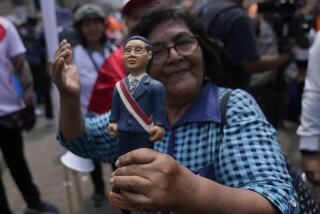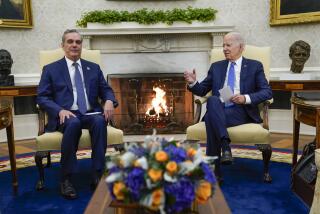Latin Nations Have Little to Show for $350 Billion in Debts
- Share via
SANTIAGE, Chile — The borrowing spree launched a decade ago to modernize Latin America has come to a painful halt with many of the largest projects unfulfilled and the region $350 billion in debt.
The burden of paying the money back to lenders has risen to 65 cents of every dollar earned from exports. For the past two years, virtually all new loans from banks have gone to pay interest owed to these same banks.
Meanwhile, huge public-works projects started with earlier loans have failed to pay off. Some are halted or slowed by the continent’s deep recession. Others were so ill-conceived they are losing millions of dollars after years in operation.
Where did the money go?
Most countries, including Brazil and Mexico, the two largest debtors, concentrated their such as dams, factories and roads, to build the basis for future prosperity. Some projects worked, others didn’t. Some show promise.
Military regimes that dominated Latin America in the 1970s borrowed billions to import new weaponry.
A commonly reported drain in some of the countries is the pockets of corrupt officials.
Even less traceable are the $80 billion in loans to private Latin American sources. (The Swiss-based Bank of International Settlements estimates that at least $50 billion slipped out of the region between 1978 and 1982 to be invested in property or banks in the same financial centers where the money was borrowed.)
Brazil completed a world-competitive steel complex and Mexico recently inaugurated the world’s longest aqueduct to relieve the city of Monterrey from chronic draught.
Brazil has also spent $14 billion in nine years building Itaipu, the world’s largest hydroelectric dam, without yet receiving a kilowatt of power. It has poured $3.5 billion into three nuclear power plants, but the only one operating is down most of the time for repairs.
Colombia’s joint venture with Exxon to open the world’s biggest open pit coal mine is expected to earn the country $100 million a year in exports, but production is at least two years away.
People Earn Less
The bottom line of the spending binge is this: Lating Americans’ per capita income rose from $2,270 in 1973 to a peak of $2,770 in 1980 but then, as the growing debt burden helped produce a recession, it fell to $2,520 last year. The people of Argentina, Bolivia, Chile, Peru and Venezuela--all heavily indebted countries--earn even less now than they did a decade ago.
Nowhere is the soul searching over borrowing habits more intense than in Argentina, where the armed forces inherited a foreign debt of nearly $9 billion upon seizing power in 1976 and quintupled it before retreating to the barracks last December.
After months of investigation just to determine the size and breakdown of the debt, the new civilian government charged that, of $43.6 billion owed by Argentina, about $30 billion was spent on unproductive ventures.
“This debt was contracted without significant compensation in physical or technological goods,” President Raul Alfonsin told his countrymen. “On the contrary, this debt brought with it the destruction of part of the productive capacity that existed here.”
Latin nations began borrowing heavily in 1974--the year after the Organization of Petroleum Exporting Countries shot up the price of oil--to defray the cost of imported oil. The loans came largely from private U.S. banks that had to recycle dollars deposited by the oil exporters. The easy credit also spurred massive oil development in Mexico and Venezuela, the region’s main producers.
Until then, Latin America had received most of its loans from governments and agencies, such as the World Bank, which lent money for specific development projects. The sudden outpouring of commercial bank credit was less discriminate.
As billions of dollars flowed to governments for “free disposition,” many countries used the money as subsidies to keep gasoline prices low. They assumed, wrongly as time proved, that the oil shock was temporary, and they became hooked on those loans by the time oil prices leaped again in 1979, forcing new borrowing to cover trade deficits.
Some improvement projects financed by foreign loans became financial sinkholes.
The city of Buenos Aires marked its 400th birthday in 1980 by opening its first expressway--one of the few visible fruits of Argentina’s borrowing. The expressways were supposed to be self financing, but too few motorists were willing to pay tolls. The city has lost $100 million.
Bolivia, borrowing against its promising oil reserves, built one of the region’s most sophisticated refineries. But that only diverted resources from exploration, and production diminished as the reserves ran down. The refinery is working at half capacity and Bolivia, which stopped exporting oil six years ago, could become an oil importer in 1985.
Lest to Corruption
SIDOR, a Venezuelan steel complex expanded with bank loans, has lost tens of millions of dollars in each of the past six years. So much cash was consumed by Venezuela’s state bureaucracy of 47 autonomous agencies that one financial analyst said “corruption was the largest project undertaken.”
Large sums disappeared from PEMEX, Mexico’s oil monopoly during the oil boom years when it borrowed $18 billion. Its former director, Jorge Diaz Serrano, is on trial with others allegedly involved in a $34-million fraud case.
In Haiti, millions of dollars lent by Canada and the International Monetary Fund vanished from the nation’s central bank in 1981, prompting both to suspend credits to Haiti until fiscal discipline was introduced.
Military hardware swallowed other large credits. Peru and Ecuador, which held a bloody border skirmish in 1981, spent about one-fourth of their foreign borrowing on imported arms. Argentina’s military chiefs spent about $8 billion preparing for the war they lost to Britain over the Falkland Islands.
A shift to free-market economies in Argentina and Chile put more loans in private hands, but made them no more productive. Overvalued currencies in both countries made foreign goods far cheaper, encouraging spending sprees for imported cars, TV sets, refrigerators and whiskey. Argentines spent an estimated $5.5 billion on shopping trips to Miami and other foreign cities.
More to Read
Sign up for Essential California
The most important California stories and recommendations in your inbox every morning.
You may occasionally receive promotional content from the Los Angeles Times.










